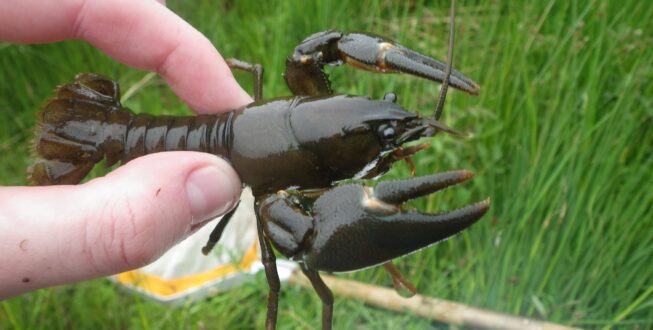North American Signal Crayfish (NASC) are a non-native invasive species that was deliberately brought to the UK in the early 80s as a farm animal, they escaped and quickly started spreading through rivers, initially in Southern England and then further north.
The first known population of North American Signal Crayfish in Scotland were found in 1995 in Loch Ken, since then they have been found in a number of other locations. They are invasive because of their ability to adapt to any freshwater habitat and outcompete many native animals, this causes a significant biodiversity loss. They cause problems for angling and can cause increased bank erosion by burying into banks.
The only successful eradication method for North American Signal Crayfish has been the use of general biocides which kill all animal species within a waterbody. This has been done in small, isolated bodies of standing water but cannot be done in any watercourse that is connected to another. All attempts of removal through trapping since the 1980s have proved unsuccessful and in many cases have caused increases in the number of individuals present, hastening their population expansion. Research has been undertaken for a number of years on the use of biocides that just target crayfish but so far there is nothing available for use.
It was inevitable that over time the crayfish would spread themselves into new areas of the River Dee system, particularly downstream of Loch Ken. It has now been confirmed that they are in Carlingwark Loch. There is currently not a known control method that will work on this scenario, but it is important that they do not spread further than the boundaries of the River Dee.
Other than deliberate movement of crayfish (which is illegal) the most likely ways in which crayfish could be moved from the River Dee and Carlingwark is either on angler’s equipment or on boating equipment. Anyone using Carlingwark should make themselves familiar with the guidance of Check Clean Dry campaign Biosecurity | Scottish Invasive Species Initiative . People should also be aware that being in possession of a live crayfish is an offence, any crayfish taken from the water should be dispatched immediately. Trapping crayfish is a criminal offence without a license, and should any traps be found, this should be reported to Police Scotland.
Any sightings of crayfish should be reported as soon as possible. You can report your finding to Scotland’s Environment Website. Please include the date seen, the number seen and the national grid reference (if you need help go to UK Grid Reference Finder). Take a photo if possible as this may help verify the record.
This statement issued by a partnership of: Galloway Glens Scheme, Galloway Fisheries Trust, Scottish Environment Protection Agency and NatureScot.






